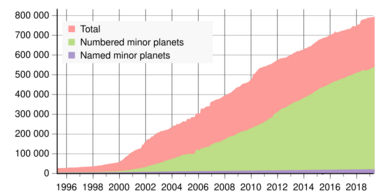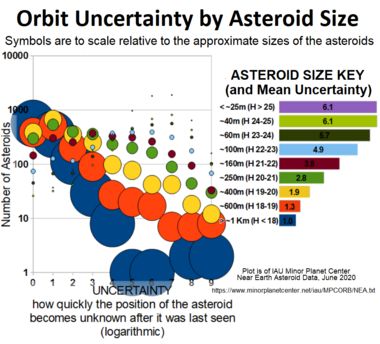Lost minor planet facts for kids
A minor planet is like a small space rock, but sometimes astronomers can't find it anymore! We call these space rocks "lost" when we don't know exactly where they are. This happens if we haven't watched them for long enough, or if we didn't make enough observations. It's like trying to find a tiny toy you dropped in a big field – if you only saw it for a second, it's hard to know where to look later!

Thousands of these small space rocks have been observed, but many are now lost. This is because we don't have enough information to predict their exact path in space. Without this, astronomers don't know where to point their telescopes to see them again.
Sometimes, a lost space rock is "recovered" by accident! This happens when a new astronomical survey finds an object that matches the path of a previously lost one. If the new object's path is very similar to the old one, scientists can figure out they are the same. This helps us learn much more about the object's journey through space. It's harder for lost comets because they can shoot out gas, which slightly changes their path. Many lost asteroids (a type of minor planet) were found again in the 1980s and 1990s, but many are still missing.
Contents
Understanding Lost Space Rocks

There might be over 150,000 lost asteroids! Also, about 30,000 space objects have a "condition code of U = 9". This means their paths are extremely uncertain. Many of these were seen years or even decades ago and are now considered lost. There are also over a thousand near-Earth objects (NEOs) that were only seen for a day or two.
The table below shows some early lost or famous asteroids. It includes when they were first seen and when they were found again.
| Name | Year it was | Notes | MPC | |
|---|---|---|---|---|
| discovered | found again | |||
| 132 Aethra | 1873 | 1922 | ||
| 1892 X (330 Adalberta) | 1892 | false positive | ||
| 452 Hamiltonia | 1899 | 1981 | ||
| 473 Nolli | 1901 | 1987 | ||
| (12126) 1999 RM11 (A904 RD) |
1904 | 1999 | ||
| 719 Albert | 1911 | 2000 | ||
| 724 Hapag | 1911 | 1988 | ||
| 843 Nicolaia | 1916 | 1981 | ||
| 878 Mildred | 1916 | 1991 | ||
| 1009 Sirene | 1923 | 1982 | ||
| 1026 Ingrid | 1923 | 1986 | ||
| 3789 Zhongguo | 1928 | 1986 | ||
| 1179 Mally | 1931 | 1986 | ||
| 1862 Apollo | 1932 | 1973 | ||
| 2101 Adonis | 1936 | 1977 | ||
| 69230 Hermes | 1937 | 2003 | ||
| 1537 Transylvania | 1940 | 1981 | ||
| 1922 Zulu | 1949 | 1974 | ||
| (29075) 1950 DA | 1950 | 2000 | ||
| 1916 Boreas | 1953 | 1976 | ||
| 3494 Purple Mountain | 1962 | 1980 | ||
| 7796 Járacimrman | 1973 | 1996 | ||
| 1927 LA | 1927 | false positive | Observed 3 times between 1 June 1927 and 5 July 1927 | MPC |
| 1991 BA | 1991 | still lost | Passed within a lunar distance of Earth | MPC |
| 1995 SN55 | 1995 | 2020 | A large space rock initially thought to be a centaur | MPC |
| 2007 WD5 | 2007 | still lost | Passed close to Mars | MPC |
| 6344 P-L | 1960 | 2007 | A potentially dangerous object; likely a sleeping comet | MPC |
Space Rocks Found in the 20th Century
Many asteroids that were only seen once became lost during the 1800s and 1900s. But thanks to better telescopes and search methods, most of these were found again between 1970 and 2000. For example, 132 Aethra was lost from 1873 until 1922.
Space Rocks Found in the 1970s
| Found Space Rock | Description |
|---|---|
| 1862 Apollo | Apollo is a type of asteroid discovered in 1932. It was lost but found again in 1973. Another Apollo asteroid is 2101 Adonis. It was found in 1936, lost, and then rediscovered in 1977. It was also one of the first near-Earth asteroids ever found. |
| 1916 Boreas | The Amor asteroid Boreas was first seen in 1953. It was rediscovered in 1974 by scientists who used a predicted location. |
| 1922 Zulu | This asteroid was found in 1949. It is one of the few asteroids that moves in a special way with Jupiter. Zulu was lost soon after it was found. It was rediscovered in 1974 based on a predicted location. |
Discoveries from the 1980s and 1990s
In 1981, scientist Leif Kahl Kristensen found 452 Hamiltonia and 1537 Transylvania again. He also found many other small objects. At that time, only nine numbered minor planets were still lost since their first discovery. These included 330 Adalberta, 473 Nolli, 719 Albert, 724 Hapag, 843 Nicolaia, 878 Mildred, 1009 Sirene, 1026 Ingrid, and 1179 Mally.
| Found Space Rock | Description |
|---|---|
| 330 Adalberta | The object first called Adalberta was seen in 1892. But it turned out to be a mistake. The name was later given to another asteroid. This asteroid was seen many times between 1910 and 1980. In 1982, scientists realized all these sightings were of the same object. |
| 843 Nicolaia | Nicolaia was first seen in 1916. It was found again in 1981. |
| 473 Nolli | Nolli was discovered in 1901. It was lost for many decades. It was finally found again in 1987, 86 years later! |
| 724 Hapag | Hapag had first been found in 1911. It was lost until it was rediscovered in 1988. |
| 719 Albert | The near-Earth asteroid 719 Albert was also found in 1911. Because its path was not known well, Albert was lost. It was not found again until 2000. Jeffrey A. Larsen found it using data from the Spacewatch project. When it was found again, Albert was the last "lost asteroid" that had been given a number. |
| 878 Mildred | Mildred was first seen in 1916 using a large telescope. But it was lost after that. It was seen again for single nights in 1985 and 1991. |
| 1009 Sirene | Sirene was found again in 1982 by J. Gibson. He used pictures from the Samuel Oschin Telescope. This helped him figure out its path better. |
| 1026 Ingrid | Ingrid was discovered in 1923. It was identified again in 1986 by Syuichi Nakano. |
| 1179 Mally | Mally was discovered in 1931. It was found again in 1986 by several scientists. |
More Amazing Recoveries
- In 1928, a scientist named Zhang Yuzhe found an asteroid. It was given the number 1125 and named "China." However, this asteroid was not seen again after its first discovery. So, its exact path could not be figured out. In 1957, a new asteroid was found. With Zhang Yuzhe's agreement, this new object was given the name 1125 China. But then, in 1986, scientists found the original 1928 asteroid again! This object was then named 3789 Zhongguo, which is also a name for China.
- The near-Earth asteroid (29075) 1950 DA was found in 1950. It was watched for 17 days and then lost. Not enough observations were made to map its path. It was found again on December 31, 2000. There is a very small chance it could hit Earth in the year 2880.
- 7796 Járacimrman was discovered in 1996. It was watched until April 1996 and then again in 1997. Scientists later found out it was a lost asteroid that had been seen before. It was observed in Italy in 1973 and in Australia in 1990.
Space Rocks Still Missing from the 20th Century
Here are some important asteroids found in the 20th century that are still lost as of 2025[update].
- 1979 XB: This space rock is about 660-metre (2,170 ft) wide. It was seen 18 times over almost 4 days in December 1979. As of 11 February 2025[update], it has a small chance of hitting Earth during four close passes in the future. The chance of it hitting in 2056 is only 1 in 5.3 million.
Lost and Found in the 21st Century
Recent Cases of Lost Space Rocks
- 6Q0B44E was found orbiting Earth in 2006. It seemed like a piece of space debris (like old rocket parts). So, it wasn't given a minor planet name. 6Q0B44E was lost in 2007. But another object, XL8D89E, was found in 2016 on a very similar path. It's likely they are the same object. It might have had a tiny gas leak that slightly changed its orbit. XL8D89E was also lost in 2018.
- 2007 WD5 is a 50 m (160 ft) Apollo-class space rock. It was found in 2007. Early observations made scientists excited because it had a chance of hitting Mars in 2008. But more observations showed the chance was very small, about 1 in 10,000. 2007 WD5 most likely passed Mars very closely. Because it passed so close, Mars's gravity might have changed its path in an unknown way. So, 2007 WD5 is now considered "lost." It passed very close to Mars and its moon Deimos.
- 2010 AU118 is a large space rock, about a kilometer wide. It was found in 2010. It was only seen 19 times over three days and has not been seen since. Scientists thought there was a tiny chance it could have hit Earth in 2020. However, it actually passed very far from Earth.
- In 2007, the object 2007 RR9 was found to be the near-Earth asteroid 6344 P–L. This asteroid had been lost since 1960. It is a potentially dangerous object and might be a dormant comet (a comet that is not active).
See also
- Lost comet
- Precovery

